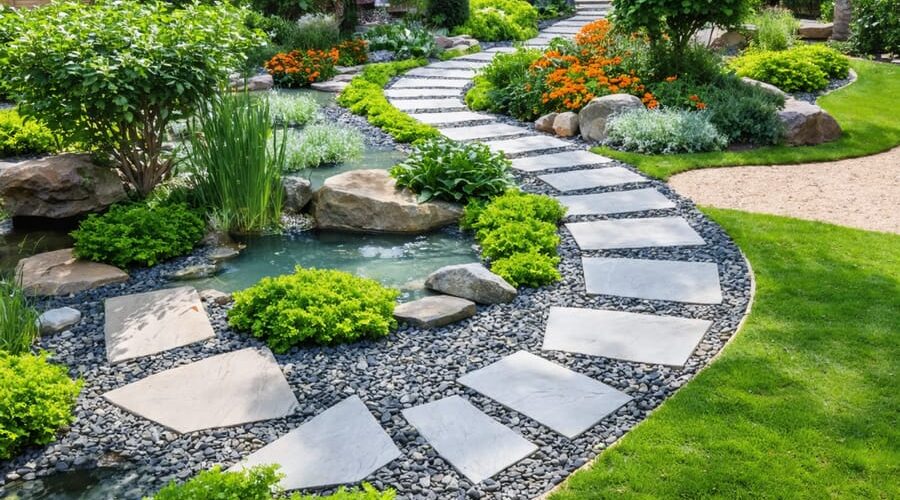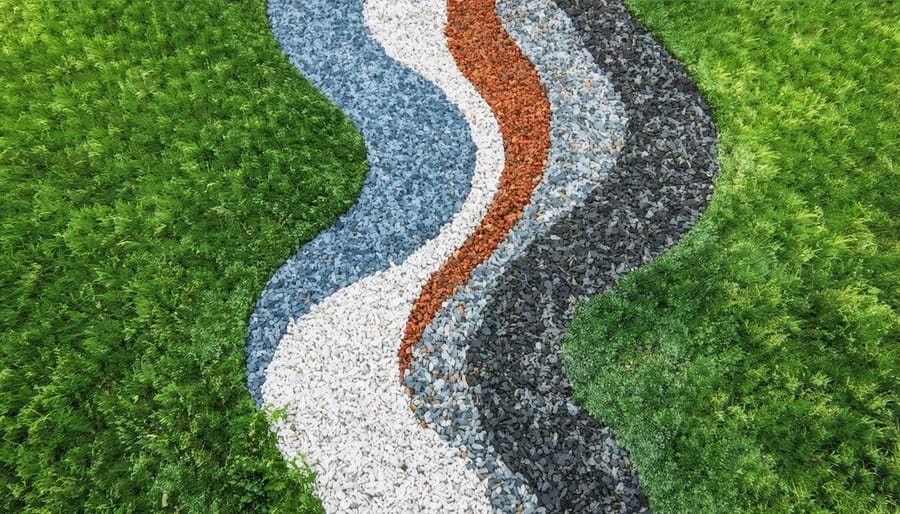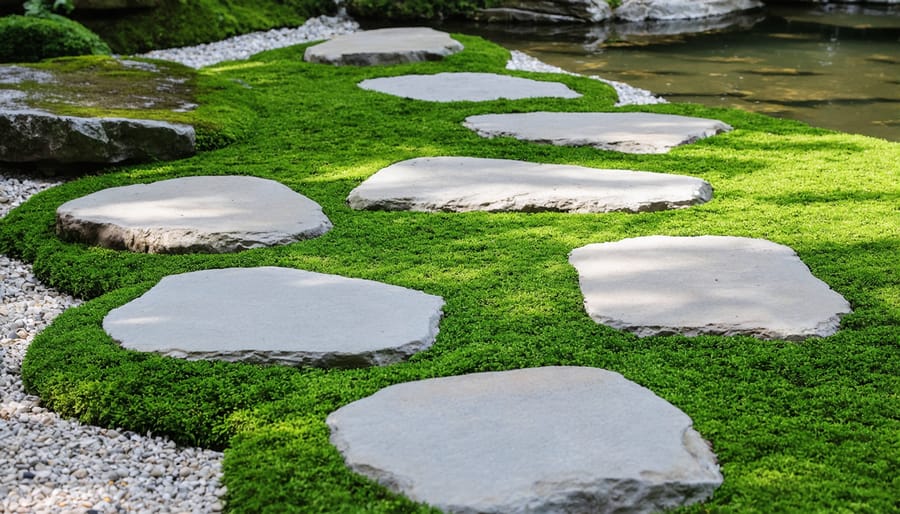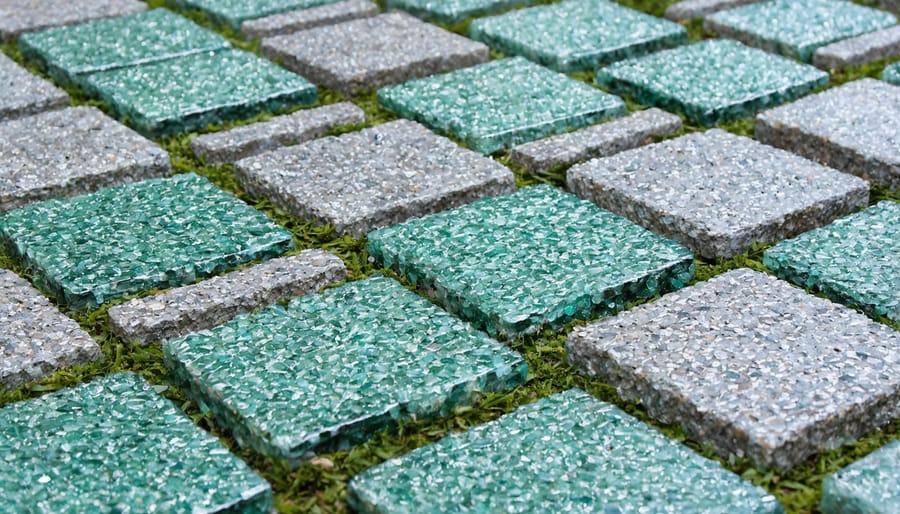
Beautiful Garden Paths That Save Water (And Your Budget)
Transform your garden path into a stunning landscape feature by selecting materials that harmonize with your outdoor water elements and enhance your garden’s natural flow. Natural stone pavers create permeable, slip-resistant surfaces perfect for areas around ponds and water feature lighting, while crushed granite offers excellent drainage and a sophisticated, low-maintenance option that prevents mud and pooling. Sustainably sourced wooden boardwalks elevate your path design, providing an elegant transition between water features while protecting delicate aquatic ecosystems underneath. Consider materials like permeable concrete pavers or recycled rubber mulch for eco-friendly alternatives that manage water runoff effectively while maintaining your garden’s natural beauty. The right path material not only guides movement through your space but also plays a crucial role in your water garden’s overall functionality and aesthetic appeal.
Permeable Materials That Let Your Garden Breathe
Gravel and Crushed Stone Solutions
Gravel and crushed stone offer versatile and budget-friendly options for garden paths, especially around water features. For a natural look, river rock gravel provides smooth, rounded stones that complement pond areas beautifully. Angular crushed stone, available in sizes from 3/8 inch to 1.5 inches, offers better stability and compaction for frequently used paths.
When installing, start with a 4-inch layer of larger stones for drainage, followed by 2-3 inches of smaller gravel on top. Always use landscape fabric underneath to prevent weeds and keep stones from mixing with soil. For the best drainage, choose angular gravel over rounded stones, as they lock together while allowing water to filter through effectively.
Popular options include pea gravel for its soft appearance and comfortable walking surface, decomposed granite for a more formal look, and crushed limestone for its natural appearance and excellent drainage properties. For paths near ponds, avoid limestone if you have acid-loving plants, as it can affect soil pH over time.
Remember to create slight crown or slope in your path for proper water runoff, and consider adding stone edging to keep gravel contained.

Permeable Pavers: The Smart Choice
Permeable pavers are a game-changer for garden paths, especially around water features. These clever materials allow rainwater to seep through rather than run off, helping to prevent flooding and reduce water pollution. You can choose from various options like open-cell concrete blocks, pervious concrete, or interlocking pavers with spacers.
Natural stone permeable pavers, such as granite or limestone, offer both beauty and functionality. Their irregular shapes create natural gaps that let water filter through while adding character to your garden. For a more uniform look, consider modern permeable concrete pavers that come in consistent sizes and patterns.
One of the biggest advantages of permeable pavers is their role in sustainable water management. They help replenish groundwater naturally and reduce the burden on storm drains. Plus, they’re perfect for areas near ponds and water gardens, as they prevent excess runoff from disturbing your water feature’s ecosystem.
Installation is straightforward – start with a base of crushed stone, add a layer of smaller aggregate, and set your pavers with spacing that allows water to penetrate. The gaps can be filled with small stones or special joint material that maintains permeability while keeping weeds at bay.
Natural Materials That Complement Your Water Garden
Stepping Stones and Natural Rock
Natural stones and stepping stones offer a timeless, organic appeal that perfectly complements water features and garden landscapes. These materials create inviting pathways that seem to have emerged naturally from the environment, especially when you illuminate your water feature alongside them for added ambiance.
When selecting natural stones, opt for flat, stable pieces at least 2 inches thick to ensure durability. Popular choices include slate, flagstone, and limestone, each bringing its unique character to your garden. Look for stones with non-slip surfaces, particularly important around water features where surfaces may become wet.
For a cohesive look, choose stones in colors that complement your existing landscaping and water features. Mixing different sizes creates visual interest, but maintain consistent spacing of 2-4 inches between stones for comfortable walking. Larger stones (18-24 inches wide) work best for primary pathways, while smaller ones are perfect for secondary routes.
When placing stepping stones, dig shallow depressions about 2 inches deep, add a layer of sand for leveling, and ensure each stone sits firmly without wobbling. Consider laying them in curved patterns rather than straight lines to create a more natural, flowing appearance that mirrors the organic movement of water in your garden.
Remember to maintain proper drainage by slightly angling stones away from water features and keeping them slightly above ground level to prevent water pooling.

Wood and Bamboo Options
Wood and bamboo bring natural warmth to garden paths while offering eco-friendly alternatives to traditional materials. Cedar and redwood are excellent choices for wet areas, as they naturally resist rot and insects. These woods can last 15-20 years when properly treated and installed with adequate drainage underneath.
For the most sustainable option, consider bamboo decking. It grows rapidly, making it highly renewable, and offers similar water resistance to hardwoods. When installing wooden paths near ponds or in damp areas, always use deck spacers between boards to allow for proper water drainage and air circulation.
To extend the life of wooden pathways, elevate them slightly above ground level using gravel or concrete blocks as a base. This prevents direct soil contact and reduces moisture absorption. Apply a water-resistant sealer annually to protect the wood from moisture damage and prevent algae growth.
For a rustic look, consider wood rounds or sleepers laid in gravel. These create charming stepping-stone effects and can be easily replaced if individual pieces deteriorate. When using pressure-treated lumber, opt for eco-friendly versions that don’t contain harmful chemicals that could leach into your garden or pond water.
Remember to install landscape fabric underneath wooden paths to prevent weed growth and maintain proper drainage. This extra step will significantly extend the path’s lifespan and reduce maintenance needs.
Recycled and Eco-Friendly Alternatives
Recycled Rubber and Composite Materials
Eco-conscious gardeners will love the innovative options available in recycled rubber and composite materials for garden paths. These sustainable alternatives transform old tires and plastic waste into durable, attractive pathway solutions. Rubber mulch and pavers made from recycled materials offer excellent slip resistance and shock absorption, making them particularly safe around water features and play areas.
These materials come in various colors and styles, from earthy tones that blend naturally with your landscape to vibrant hues that create striking visual effects. The porous nature of recycled rubber allows for excellent drainage, preventing water pooling and reducing runoff – a crucial feature for water garden designs.
Composite materials, often made from a blend of recycled plastic and wood fibers, provide another sustainable option. These materials resist rot, don’t splinter like traditional wood, and maintain their appearance for years with minimal maintenance. They’re also lightweight and easy to install, making them perfect for DIY projects.
Both options offer exceptional durability in all weather conditions and won’t crack or deteriorate when exposed to moisture, making them ideal for garden paths near ponds and water features.
Glass and Concrete Alternatives
For an eco-friendly twist on traditional path materials, recycled glass aggregates offer a stunning alternative that sparkles in the sunlight. These colorful fragments, tumbled smooth for safety, can be mixed with permeable binders to create unique pathways that complement water features beautifully. The glass pieces allow water to drain effectively while adding an artistic element to your garden design.
Eco-concrete alternatives are gaining popularity among environmentally conscious gardeners. Products like pervious concrete and glass-fiber reinforced concrete (GFRC) provide durability with a smaller environmental footprint. These materials contain recycled components and require less cement than traditional concrete, reducing their carbon impact.
Another innovative option is glass-infused permeable pavers. These combine recycled glass with eco-friendly binding agents to create sturdy, decorative blocks that allow water to seep through naturally. They’re particularly effective around pond areas, helping to prevent water pooling while adding visual interest.
For a truly sustainable approach, consider crushed glass mulch bordered with reclaimed concrete pieces. This combination provides excellent drainage and requires minimal maintenance, while giving your garden path a modern, environmentally responsible aesthetic.

Installation and Maintenance Tips
Installing a garden path requires careful planning and preparation for long-lasting results. Start by marking your path’s layout using string or garden hoses to visualize the flow. Clear the area of vegetation and dig down about 4-6 inches, ensuring the ground is level. For proper drainage, create a slight slope away from any buildings or water features.
Add a layer of landscape fabric to prevent weed growth, followed by a 2-inch base of compacted gravel or crushed stone. This foundation is crucial for stability and drainage, especially around water features. When laying your chosen material, work in small sections and use appropriate tools – a rubber mallet for pavers, a trowel for gravel, or boards for creating clean edges with decomposed granite.
For maintenance, regular sweeping keeps paths clear of debris and prevents material migration. Address weeds promptly by hand-pulling or using eco-friendly weed preventives. Consider how your path will look during evening hours and integrate outdoor lighting design to enhance safety and ambiance.
Refresh loose materials like gravel or wood chips annually, adding new material as needed. For stone or concrete pavers, check regularly for shifting or settling, and re-level as necessary. During wet seasons, ensure water drains properly and address any pooling issues by adjusting the grade or adding drainage solutions.
Remember to maintain edging materials to prevent path materials from spreading into garden beds or water features. Clean any algae growth on stones near water features using a gentle pressure washer or biodegradable cleaner to maintain safety and appearance.
As we’ve explored, sustainable garden path materials offer both environmental benefits and practical advantages for your outdoor space. By choosing permeable materials like gravel, recycled pavers, or natural stone, you’re helping reduce water runoff while creating beautiful, long-lasting pathways. These eco-friendly options not only complement your water features but also support local wildlife and maintain the natural balance of your garden. Remember, every sustainable choice we make in our gardens contributes to a healthier planet. Whether you opt for reclaimed materials or locally sourced alternatives, your path selection can make a real difference. Take time to consider how your chosen materials will work with your garden’s ecosystem, and don’t be afraid to mix different sustainable options to create a unique and environmentally responsible pathway that you’ll enjoy for years to come.
